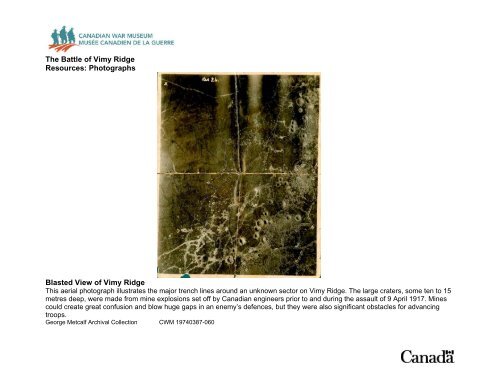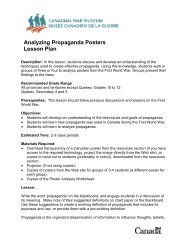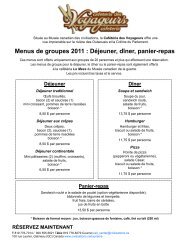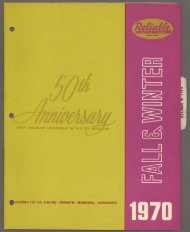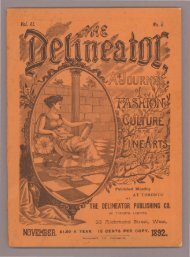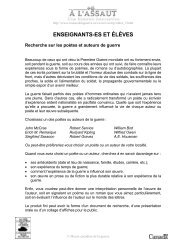Battle of Vimy Ridge (pdf) - Canadian War Museum
Battle of Vimy Ridge (pdf) - Canadian War Museum
Battle of Vimy Ridge (pdf) - Canadian War Museum
You also want an ePaper? Increase the reach of your titles
YUMPU automatically turns print PDFs into web optimized ePapers that Google loves.
The <strong>Battle</strong> <strong>of</strong> <strong>Vimy</strong> <strong>Ridge</strong><br />
Resources: Photographs<br />
Blasted View <strong>of</strong> <strong>Vimy</strong> <strong>Ridge</strong><br />
This aerial photograph illustrates the major trench lines around an unknown sector on <strong>Vimy</strong> <strong>Ridge</strong>. The large craters, some ten to 15<br />
metres deep, were made from mine explosions set <strong>of</strong>f by <strong>Canadian</strong> engineers prior to and during the assault <strong>of</strong> 9 April 1917. Mines<br />
could create great confusion and blow huge gaps in an enemy’s defences, but they were also significant obstacles for advancing<br />
troops.<br />
George Metcalf Archival Collection CWM 19740387-060
The <strong>Battle</strong> <strong>of</strong> <strong>Vimy</strong> <strong>Ridge</strong><br />
Resources: Photographs<br />
Tank at <strong>Vimy</strong><br />
British tank crossing German trench at <strong>Vimy</strong> <strong>Ridge</strong>. All eight <strong>of</strong> the tanks available to the <strong>Canadian</strong>s at <strong>Vimy</strong> broke down or were<br />
knocked out by enemy fire. The slow-moving tanks were nevertheless useful in crushing barbed wire, terrifying the enemy, and<br />
supporting the infantry.<br />
George Metcalf Archival Collection CWM 19930013-548
The <strong>Battle</strong> <strong>of</strong> <strong>Vimy</strong> <strong>Ridge</strong><br />
Resources: Photographs<br />
Beyond <strong>Vimy</strong>, the Douai Plain<br />
This photograph, taken after the capture <strong>of</strong> <strong>Vimy</strong> <strong>Ridge</strong>, looks east over the Douai Plain. The vantage point occupied by the soldiers<br />
in the foreground demonstrates the strategic importance <strong>of</strong> <strong>Vimy</strong> <strong>Ridge</strong> – its height.<br />
George Metcalf Archival Collection CWM 19920085-244
The <strong>Battle</strong> <strong>of</strong> <strong>Vimy</strong> <strong>Ridge</strong><br />
Resources: Photographs<br />
<strong>Canadian</strong>s Advance<br />
<strong>Canadian</strong>s <strong>of</strong> the 29th Infantry Battalion advance across No Man's Land through the German barbed wire during the battle <strong>of</strong> <strong>Vimy</strong><br />
<strong>Ridge</strong>, April 1917. Most soldiers are armed with their Lee Enfield rifles, but the soldier in the middle carries a Lewis machine-gun on<br />
his shoulder.<br />
George Metcalf Archival Collection CWM 19920085-915
The <strong>Battle</strong> <strong>of</strong> <strong>Vimy</strong> <strong>Ridge</strong><br />
Resources: Photographs<br />
<strong>Vimy</strong> Fortifications<br />
A German machine-gun emplacement <strong>of</strong> reinforced concrete on the crest <strong>of</strong> <strong>Vimy</strong> <strong>Ridge</strong>, and the <strong>Canadian</strong>s who seized it.<br />
George Metcalf Archival Collection CWM 19920085-917
The <strong>Battle</strong> <strong>of</strong> <strong>Vimy</strong> <strong>Ridge</strong><br />
Resources: Photographs<br />
Removing Casualties<br />
<strong>Canadian</strong> medical <strong>of</strong>ficers (with the Red Cross emblems on the soldiers at right and to the left rear <strong>of</strong> the photo) use German<br />
prisoners to help transport <strong>Canadian</strong> wounded from <strong>Vimy</strong> <strong>Ridge</strong>, April 1917. They use a two-tiered carrier, pulled along a light railway<br />
line leading from the front.<br />
George Metcalf Archival Collection CWM 19920085-924
The <strong>Battle</strong> <strong>of</strong> <strong>Vimy</strong> <strong>Ridge</strong><br />
Resources: Photographs<br />
Prisoners <strong>of</strong> <strong>War</strong><br />
The <strong>Canadian</strong>s captured more than 4,000 Germans during the <strong>Battle</strong> <strong>of</strong> <strong>Vimy</strong> <strong>Ridge</strong>. In this photograph, the soldiers in the s<strong>of</strong>t caps<br />
are German <strong>of</strong>ficers, and perhaps senior enough to warrant the attention <strong>of</strong> the <strong>of</strong>ficial <strong>Canadian</strong> photographer.<br />
George Metcalf Archival Collection CWM 19920085-943<br />
.
The <strong>Battle</strong> <strong>of</strong> <strong>Vimy</strong> <strong>Ridge</strong><br />
Resources: Photographs<br />
Artillery Support<br />
In this striking nighttime photograph taken behind <strong>Canadian</strong> lines at <strong>Vimy</strong> <strong>Ridge</strong>, a British naval gun fires in support <strong>of</strong> the <strong>Canadian</strong><br />
attack. Approximately 1,000 Allied guns and mortars pounded the ridge prior to the assault, a period called by the German<br />
defenders the “week <strong>of</strong> suffering.”<br />
George Metcalf Archival Collection CWM 19920085-215
The <strong>Battle</strong> <strong>of</strong> <strong>Vimy</strong> <strong>Ridge</strong><br />
Resources: Photographs<br />
Byng Inspecting Captured Gun<br />
Lieutenant-General Sir Julian Byng and an unknown French <strong>of</strong>ficer inspect German guns captured at <strong>Vimy</strong> <strong>Ridge</strong>. During the fourday<br />
battle from 9 to 12 April 1917, the <strong>Canadian</strong>s captured 54 guns, 104 trench mortars, and 124 machine-guns.<br />
George Metcalf Archival Collection CWM 20020045-2436
The <strong>Battle</strong> <strong>of</strong> <strong>Vimy</strong> <strong>Ridge</strong><br />
Resources: Photographs<br />
Byng <strong>of</strong> <strong>Vimy</strong><br />
Lieutenant-General Sir Julian Byng commanded the <strong>Canadian</strong> Corps on the Western Front from May 1916 to June 1917. He forged<br />
the <strong>Canadian</strong>s into an elite fighting formation, leading them through the battles <strong>of</strong> Mount Sorrel, the Somme, and <strong>Vimy</strong> <strong>Ridge</strong>. His<br />
<strong>Canadian</strong> troops called themselves the “Byng Boys,” a testament to their commander’s popularity. This photograph, from April 1917,<br />
reveals a tired and haggard Byng who, like so many, was aged by the war.<br />
George Metcalf Archival Collection CWM 19920085-262
The <strong>Battle</strong> <strong>of</strong> <strong>Vimy</strong> <strong>Ridge</strong><br />
Resources: Photographs<br />
<strong>Canadian</strong> Cemetery at <strong>Vimy</strong><br />
Aerial view <strong>of</strong> the <strong>Canadian</strong> cemetery near <strong>Vimy</strong> <strong>Ridge</strong>. The <strong>Battle</strong> <strong>of</strong> <strong>Vimy</strong> <strong>Ridge</strong>, a significant victory in April 1917, resulted in the<br />
deaths <strong>of</strong> 3,598 <strong>Canadian</strong>s.<br />
George Metcalf Archival Collection CWM 19801226-298
The <strong>Battle</strong> <strong>of</strong> <strong>Vimy</strong> <strong>Ridge</strong><br />
Resources: Photographs<br />
<strong>Vimy</strong> Dedication<br />
Flags are hoisted in preparation for the dedication <strong>of</strong> the Memorial at <strong>Vimy</strong> <strong>Ridge</strong>. The 26 July 1936 unveiling was attended by<br />
100,000, including 6,000 <strong>Canadian</strong> veterans. The two pillars represent France and Canada. The lone sculpture represents Canada<br />
mourning her fallen sons.<br />
George Metcalf Archival Collection CWM 19810859-009
The <strong>Battle</strong> <strong>of</strong> <strong>Vimy</strong> <strong>Ridge</strong><br />
Resources: Photographs<br />
<strong>Vimy</strong> Pilgrims<br />
A massive crowd gathers to watch the unveiling <strong>of</strong> the <strong>Vimy</strong> <strong>Ridge</strong> Memorial on 26 July 1936. The two soaring pylons represent<br />
Canada and France. Twenty other sculpted figures adorn the structure.<br />
George Metcalf Archival Collection CWM 19910181-036
The <strong>Battle</strong> <strong>of</strong> <strong>Vimy</strong> <strong>Ridge</strong><br />
Resources: Photographs<br />
A <strong>Canadian</strong> Grave<br />
A <strong>Canadian</strong> soldier tends to the informal grave <strong>of</strong> a comrade killed in action near <strong>Vimy</strong> <strong>Ridge</strong>, April 1917.<br />
George Metcalf Archival Collection CWM 19920085-400
The <strong>Battle</strong> <strong>of</strong> <strong>Vimy</strong> <strong>Ridge</strong><br />
Resources: Photographs<br />
Walter Allward<br />
An autographed portrait <strong>of</strong> Walter Allward, sculptor and designer <strong>of</strong> the <strong>Vimy</strong> <strong>Ridge</strong> Memorial. Allward's design was chosen from<br />
among 160 entries in a national competition held in 1921.<br />
George Metcalf Archival Collection CWM 19900066-001
The <strong>Battle</strong> <strong>of</strong> <strong>Vimy</strong> <strong>Ridge</strong><br />
Resources: Photographs<br />
Early Memorial<br />
An early memorial at <strong>Vimy</strong> <strong>Ridge</strong> in October 1917 honours the 2nd <strong>Canadian</strong> Division and the13th British Infantry Brigade that fought<br />
together during the battle. Memorials were <strong>of</strong>ten erected by units and formations after major battles.<br />
George Metcalf Archival Collection CWM 19930013-362


